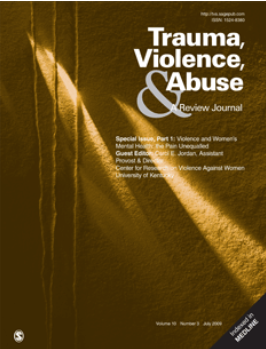不同类型的儿童受害与儿童和青少年游戏障碍之间的关系:一项荟萃分析。
IF 5.4
1区 社会学
Q1 CRIMINOLOGY & PENOLOGY
引用次数: 0
摘要
儿童受害对儿童和青少年健康的许多方面产生负面影响。越来越多的研究调查了儿童受害对游戏障碍(GD)的影响,尽管研究结果尚无定论。为了解决这一问题,在本荟萃分析研究中,我们定量地综合了不同类型的儿童受害与焦虑之间的关联的现有经验证据,并考察了研究和参与者特征是否调节了这种关联。通过在PubMed、CINAHL Complete、Embase、PsycINFO和Web of Science数据库中进行系统搜索,确定了2023年12月8日之前发表的关于受害与GD之间关系的研究。36项研究(112,057名参与者)符合研究选择标准,并显示儿童受害与性别焦虑之间存在显著关联,效应量较小(r = 0.221;95%可信区间,CI [0.174, 0.268], p < .001)。不同受害类型的综合效应值从r =。154 ~ 0.218 (ps < 0.05)。总体效应大小相对一致,与参与者的年龄和性别、研究区域、研究质量和抽样方法无关。研究设计和研究样本是仅有的两个显著调节因子,横截面研究的合并效应量更大(r = 0.245;[0.188, 0.300])和临床样本(r = .468;[0.328, 0.588])。儿童受害是性别焦虑的一个重要风险因素,无论具体的受害类型如何。建议采取针对多种受害类型的预防战略。本文章由计算机程序翻译,如有差异,请以英文原文为准。
Associations Between Different Types of Child Victimization and Gaming Disorder in Children and Adolescents: A Meta-Analysis.
Child victimization negatively impacts many aspects of health in children and adolescents. An increasing number of studies have examined the influence of child victimization on gaming disorder (GD), though findings have been inconclusive. To address this problem, in this meta-analytic study, we quantitatively synthesized existing empirical evidence on the associations between different types of child victimization and GD and examined whether study and participant characteristics moderate the association. Studies examining the relationship between victimization and GD published before December 8, 2023 were identified through systematic searches conducted in PubMed, CINAHL Complete, Embase, PsycINFO, and Web of Science databases. Thirty-six studies (112,057 participants) met the study selection criteria and showed a significant association between child victimization and GD, with a small effect size (r = .221; 95% confidence interval, CI [0.174, 0.268], p < .001). The pooled effect sizes for different types of victimization ranged from r = .154 to .218 (ps < .05). The overall effect size is relatively consistent, independent of age and sex of participants, study regions, study quality, and sampling methods. Study design and study samples are the only two significant moderators, with larger pooled effect sizes for cross-sectional studies (r = .245; [0.188, 0.300]) and clinical samples (r = .468; [0.328, 0.588]). Child victimization is a significant risk factor for GD, regardless of the specific type of victimization. Prevention strategies addressing multiple types of victimization are recommended.
求助全文
通过发布文献求助,成功后即可免费获取论文全文。
去求助
来源期刊

Trauma Violence & Abuse
Multiple-
CiteScore
13.60
自引率
7.80%
发文量
131
期刊介绍:
Trauma, Violence, & Abuse is devoted to organizing, synthesizing, and expanding knowledge on all force of trauma, abuse, and violence. This peer-reviewed journal is practitioner oriented and will publish only reviews of research, conceptual or theoretical articles, and law review articles. Trauma, Violence, & Abuse is dedicated to professionals and advanced students in clinical training who work with any form of trauma, abuse, and violence. It is intended to compile knowledge that clearly affects practice, policy, and research.
 求助内容:
求助内容: 应助结果提醒方式:
应助结果提醒方式:


